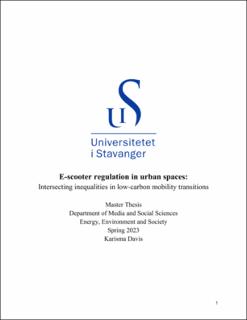| dc.description.abstract | What ways are e-scooters regulated as they penetrate urban space? Which actors have decision-making power in practice, and with what implications for the interests of diverse social groups that undertake mobility in cities? In this thesis, I operationalize these questions through a case study of e-scooters in Stavanger. This entails an application of two theories: Avoid-Shift-Improve (A-S-I) and Transport Related Social Exclusion (TRSE). Through the use of these two theories, I explore intersecting inequalities in urban space by focusing on different approaches to mobility transitions, the history and concept of public space, and imaginaries of sustainable cities. The study comprises three expert interviews, document analysis including United Nations reports, mission statements, and city development plans; discourse analysis; and participant observation in the form of attending an annual mobility conference. My empirical analysis suggests that while the sustainable benefits of e-scooters are context-dependent, they are simultaneously framed as a universal sustainable mobility tool by e-scooter operators and in certain imaginaries of sustainable cities such as the Smart City, while generally disregarded in discussions about their specific role in achieving sustainable city development goals by policymakers. This disregard impacts diverse population groups in exclusionary and harmful ways. I discuss this in relation to scholarship on the viability of e-scooters and approaches to sustainable and accessible mobility, and how different groups are unequally affected by such approaches and applications within public space. Overall, this is framed in relation to intersecting inequalities that must be considered during regulation of new technological interventions like e-scooters. In this case study, gaps between actors who constitute the regulatory apparatus led to narrow outcomes, with the consequence of marginalizing the inhabitants who are directly affected by these applications. | |
